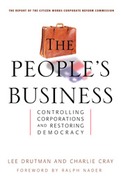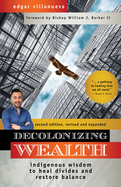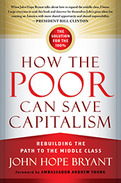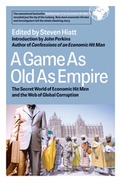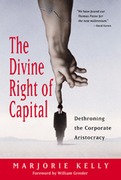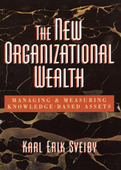More than ever, large corporations wield an unjustifiably excessive influence over our lives. The consequences are indeed frightening-environmental destruction, political corruption, erosion of democracy, increased polarization between rich and poor, declining wages and benefits, increased stress and overwork. As corporations become more powerful, these problems will only get worse.
The People's Business offers a comprehensive series of proposals for reforming and restructuring corporations so that they become the people's servants, not their masters. Writing in a lively populist style, the authors pull together recommendations from the prestigious members of the Citizen Works Commission on Corporate Reform to present a clear-headed plan of action.
Drutman and Cray discuss how corporations managed to achieve their current privileged position and offer a comprehensive approach for reconceiving corporations as engines of public prosperity, not private plunder. They outline specific reforms that could be enacted to get corporations out of politics, establish truly public-minded regulation of corporate behavior, safeguard our natural resources, combat unfair market domination by corporations, crack down on corporate crime, and challenge the corporate claim to constitutional rights.
Bolstered with relevant history and recent examples, The People's Business is a lively book that will appeal both to deeply-committed (and often frustrated) long-time activists looking for a coherent approach in the struggle for corporate accountability, as well as relative newcomers looking for immediate measures that could serve as effective means of corporate reform.
- The official report of a commission of 50 prominent leaders of the corporate reform movement that includes such notable members as Ralph Nader, David Korten, Herman Daly, Medea Benjamin, and many others
- Includes specific, detailed prescriptions for how we can take our country back from corporate rule and integrates them into a coherent strategy
- Written in an engaging, hard-hitting style with lots of concrete examples
The world is out of balance. With increasing frequency, we are presented with the inescapable truth that systemic racism and colonial structures are foundational principles to our economies. The $1 trillion philanthropic industry is one example of a system that mirrors oppressive colonial behavior. It's an industry whose name means “the love for humankind,” yet it does more harm than good.
In Decolonizing Wealth, Edgar Villanueva looks past philanthropy's glamorous, altruistic façade and into its shadows: white supremacy, savior complexes, and internalized oppression. Across history and to the present day, the accumulation of wealth is steeped in trauma. How can we shift philanthropy toward social reconciliation and healing if the cornerstones are exploitation, extraction, and control?
Drawing from Native traditions, Villanueva empowers individuals and institutions to begin to repair the damage through his Seven Steps to Healing. In this second edition, Villanueva adds inspiring examples of people using their resources to decolonize entertainment, museums, libraries, land ownership, and much more.
Everyone can be a healer and a leader in restoring balance—and we need everyone to do their part. As Villanueva writes, “All our suffering is mutual. All our healing is mutual. All our thriving is mutual.” Are you ready?
Raised in poverty-stricken, gang-infested South Central Los Angeles, Bryant saw firsthand how our institutions have abandoned the poor. He details how business loans, home loans, and financial investments have vanished from their communities. After decades of deprivation, the poor lack bank accounts, decent credit scores, and any real firsthand experience of how a healthy free enterprise system functions.
Bryant radically redefines the meaning of poverty and wealth. (It's not just a question of finances; it's values too.) He exposes why attempts to aid the poor so far have fallen short and offers a way forward: the HOPE Plan, a series of straightforward, actionable steps to build financial literacy and expand opportunity so that the poor can join the middle class.
Fully 70 percent of the American economy is driven by consumer spending, but more and more people have too much month at the end of their money. John Hope Bryant aspires to “expand the philosophy of free enterprise to include all of God's children” and create a thriving economy that works not just for the 1 percent or even the 99 percent but for the 100 percent. This is a free enterprise approach to solving the problem of poverty and raising up a new America.
• Builds on the shocking picture of worldwide economic corruption first presented in John Perkins' Confessions of an Economic Hit Man
• Features a dozen chapters detailing contemporary examples of how the economic hit man game is played around the globe
John Perkins’ controversial and bestselling exposé, Confessions of an Economic Hit Man, revealed for the first time the secret world of economic hit men (EHMs). But Perkins’ Confessions contained only a small piece of this sinister puzzle. The full story is far bigger, deeper, and darker than Perkins’ personal account revealed. Here other EHMs, journalists, and investigators join Perkins to tell their own stories, providing the first probing and expansive look into this pervasive web of systematic corruption.
With chapters spotlighting how specific countries around the globe have been subverted, A Game As Old As Empire uncovers the inner workings of the institutions behind these economic manipulations. The contributors detail concrete examples of how the “economic hit man game” is still being played: an officer of an offshore bank hiding hundreds of millions of dollars in stolen money, IMF advisers slashing Ghana’s education and health programs, a mercenary defending a European oil company in Nigeria, a consultant rewriting Iraqi oil law, and executives financing warlords to secure supplies of coltan ore in Congo. Together they show how this system of corruption and plunder operates in real life, and reveal the price that the rest of the world must pay as a result.
Most important, A Game As Old As Empire connects the dots, showing how the various pieces of this system come together to create the world’s first truly global empire.
- Updated paperback edition includes a new chapter and a Reader's Guide
- Explores the real causes of the Enron fiasco and other recent corporate scandals
- Explodes the myth that the stock market is "democratizing" wealth
- Gives practical guidance to help employees and communities change corporate governance and unfetter the genius of the free market
Shares in Microsoft, the world's largest computer software firm, changed hands at an average price of $70 during 1995, at a time when their "book value" or "equity" was just $7. In other words, for every $1 of tangible value, the market saw $9 of additional value, for which there was no corresponding record in Microsoft's balance sheet. This extra $9 in the value of Microsoft shares represents a major trend. More and more, companies are deriving value from their intangible assets. These assets include their employee's creative ideas, their customers' loyalty, their ability to attract and keep prestigious accounts, their innovative products and services, their popular brand names, and their reputation.
Knowledge-based organizations with intangible assets, such as accounting and legal firms, management consultants, advertising agencies, medical clinics and hospitals, software and engineering companies, and the art and entertainment industry make up the fastest growing business sector. Yet few of these companies achieve their potential performance and profitability because they do not know how to exploit their intangible assets. They measure performance only in terms of money, ignoring less tangible but vital assets such as the ability to capture high profile customers or the creativity to keep the company on the cutting edge with innovative products or services.
The New Organizational Wealth shows how some of the fastest-growing, most profitable companies are discovering that potentially limitless revenues can flow from their firm's intangible assets-the ability of employees, customers, and even suppliers to create new concepts, models, products, and services. Among the book's many examples is Netscape Communications. This successful company demonstrates the profitable results of fostering long-term customer relationships and the effectiveness of investing in employee competence to maintain a rich pool of talent.
The New Organizational Wealth outlines the conceptual framework for changing business strategies to focus on intangible assets. Using its guidelines, managers can learn how to identify the indicators for their company's intangible assets-their employee's talents and strengths, their customers' support and interest, and their supplier's reliability and ingenuity. Specific chapters detail how to effectively use and measure these "tacit" assets, as well as how to monitor them for financial success. Helpful case studies of Scandanavian companies such as WM-data-s, Skandia AFS, and Celemi, which have developed systems for measuring intangible assets and publicly reporting the results, provide models managers can use in leading their companies to increased profitability and long-term organizational success.
- The first book on managing and measuring intangible assets
- Shows how to tap customer and employee knowledge to build a more successful organization
- Provides tools for measuring such intangible assets as competent and creative employees, patents, brand names, or company reputation
- Written by an experienced manager who played a key role in developing the "Scandinavian Movement" of management


